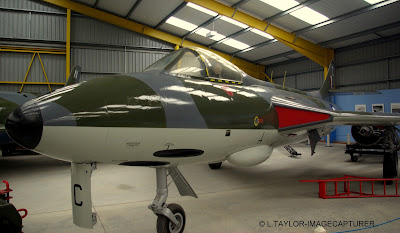ENGLISH ELECTRIC P1.
Research plane.
The first flight of P1 WG760 was on 4th August 1954, just 10 years after the RAF`s first jet aircraft, the Meteor entered service. It was experimental and was the basis for the RAF`s front line fighter, the English Electric ( later BAC ) lightning. It was the first and only truly supersonic aircraft developed by Britain on her own.
~~~~<<<<>>>>~~~~
FAIRCHILD ARGUS 11.
In RAF service, most Argus aircraft operated in the vital but unsung general communications and liaison role. They were extensively used in the near and far east and South Africa. In the United Kingdom they were more widely used by the Air Transport Auxiliary ( ATA ) to ferry delivery pilots to and from factories and airfields.
~~~~<<<<>>>>~~~~
DE HAVILLAND DEVON C2/2A.
Transport and Communication aircraft.
The Devon aircraft was developed for the RAF from the civil De Havilland Dove 4 as a light communications and transport aircraft. The De Havilland Dove was designed to replace the biplane De Havilland Rapide. It first flew on 25th September 1945. A military version known as the Devon C1 was produced and about 30 aircraft were supplied to the RAF from 1947. Others were acquired for the Royal Aircraft Establishment ( RAE ), the empire test pilots school and the fleet air arm. This particular aircraft was the first to be supplied to the RAF and was used in the military trials by the Handling Squadron at RAF Hullavington. The civilian Devon was a commercial success. Some 500 aircraft were produced and they flew in practically every country in the world.
~~~~<<<<>>>>~~~~
BAE EAP.
Experimental aircraft programme.
EAP flew from 1986 to 1991. It was used to develop the advanced technologies and flight systems intended for what became the Eurofighter Typhoon.
~~~~<<<<>>>>~~~~
BRITISH AIRCRAFT CORPORATION JET PROVOST T MK 5A XW418.
Trainer.
This is the last variety of the Jet Provost series. It was built in 1972. This aircraft was used at no1 flying training school RAF Linton on Ouse, no3 flying training school at RAF Leeming, no7 flying training school at RAF Church Fenton, central flying school at RAF Scampton, before becoming a ground instructional airframe at RAF Cosford.
~~~~<<<<>>>>~~~~
HAWKER CYGNET.
Light sporting aeroplane.
Early in 1924 the Royal Aero Club organised a light aeroplane competition for which the Air Ministry offered £3000 in prizes. The hope was to develop light aircraft so that private flying would become popular as owning a motor car. Only two Cygnets were built and both were entered in the completion held at Lympne in September 1924. Both survived the elimination rounds and were placed 3rd and 4th in the final.
~~~~<<<<>>>>~~~~
DE HAVILLAND VAMPIRE T.11 XD593.
Two seat advanced trainer.
Aircrew - two, Max speed - 549mph, Range - 863 miles, Armament - none, Power plant - one De Havilland Goblin 35 engine rated at 3,400lbs static thrust.
~~~~<<<<>>>>~~~~
DE HAVILLAND SEA VENOM FAW.22 WW217.
Shipboard strike fighter.
Aircrew - two, Max speed - 563mph, Range - 800 miles, Armament - four 20mm Hispano Cannon, eight 27kg rockets, Power plant - one De Havilland Ghost 105 rated at 5,150lbs static thrust.
~~~~<<<<>>>>~~~~
ARMSTRONG WHITWORTH METEOR N.F.12 WS692.
Night fighter aircraft.
Aircrew - two, Max speed - 541mph, Range - 960 miles, Armament - four 20mm Cannon, Power plant - two Rolls Royce Derwent 9 engines each rated at 3,800lbs static thrust.
~~~~<<<<>>>>~~~~
LEE RICHARDS ANNULAR BIPLANE ( replica ).
Early flying machine.
Aircrew - one, Max speed - 35mph, Range - very short, Span - 20 foot diameter, Power plant - 50 hp rotary Gnome engine.
~~~~<<<<>>>>~~~~
HAWKER HUNTER F.1. WT651.
Interceptor Fighter.
Aircrew - one, Max speed - 715mph, Range - 1,840 miles, Service ceiling - 48,500ft, Loaded weight - 16,200lbs, Armament - four 30mm Aden Cannons, Power plant - one Rolls Royce Avon RA.7 rated at 7,500lbs static thrust.
~~~~<<<<>>>>~~~~
SURVEILLANCE DRONE - CSV30.
The CSV30 is an enhanced and enlarged version of the CSV 20 providing increased capability. The airframe shown was constructed to carry out Magnetometer rock strata mapping for geological survey work. The wingtip pods are built to carry, respectively, a magnetometer sensor head and a GPS transmitter. Complete data is transferred back to the base control unit together with real time video. Transit speed - 175kph, Loiter speed - 70kph, Wing span - 2.75m, Length - 2.2m, Wight - 22kg, Endurance - 120mins, Motor size - 45 - 75 ccs.
~~~~<<<<>>>>~~~~












Oh, goodie! Planes!!! I have heard of the companies that made most of these, but not the models. But I will say right now that there ain't no way I'd get on the Lee Richards Bi Plane thing. uhuh Drones are very cool as long as they don't watch me. The Hunter Hawker seems to be a bit under armed to me. Just 4 cannons? The Sea Venom looks MEAN! The Cygnet looks interesting but not interesting enough for me to go up in it. The P1 looks somewhat like an early American jet fighter but I can't remember the name of it. Looks interesting. Never was one for loving one engine prop planes though they generally are quite reliable. But that De Havilland Devon looks mighty good. The BEA EAP looks sleek! Really sleek! Good photos and great planes you picked this time, Les!!!
ReplyDelete